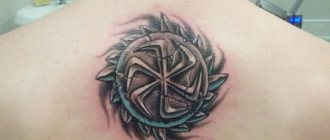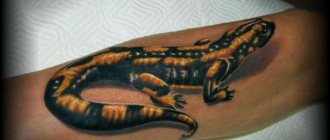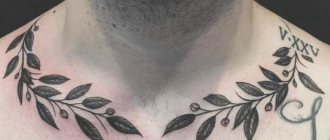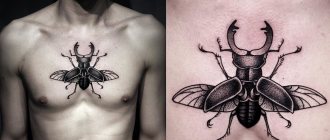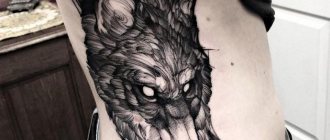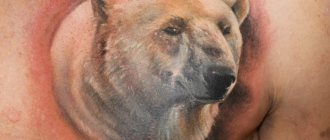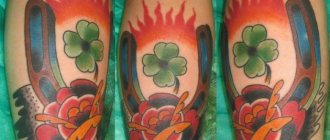Ancient Slavic drawings on the human body had a strong protective effect. Perun - power and honor for men, the goddess Makosh tattoos for women, bestowing intuition and femininity. Body painting occupied a separate niche in pagan culture, echoes of which have reached our times. Today, ethnic tattoos are especially popular, and this fact explains not only the desire to revive the traditions of their ancestors, but also the desire to protect themselves from evil rock and the machinations of fate.
Egyptian tattoo amulets and their meaning
Tattoo amulets of the Egyptian Gods are considered especially sacred, symbolizing power in conjunction with the divine power of the owner of the design. However, among the images symbolizing intelligence, beauty, and strength, there are a number of tattoo amulets that protect their owner from various troubles and diseases. These also include drawings of gods, animals and inanimate objects.
Tattoos and their meanings: 4 types of designs with magical meanings
1) Anubis
The mystical and unknown deity of the ancient country, through which the great Nile flows, is considered the patron of the dead and the ruler of the underworld, the guardian of graves and mummies.
The deity with the head of a jackal is a kind of intermediary for all the dead who need to find themselves in another world. Anubis appears to be the guardian of poisons and all kinds of medicines, which makes his possibilities limitless, and modern psychiatrists consider him their patron.
The ancient deity rewarded or condemned not only the human race, but also other deities for various deeds, which allows us to judge from the owner of the tattoo that he knows everything about everyone, and has the power to reward for misdeeds and exploits. There is a theory that the Egyptian Anubis is identified with Jesus Christ, helping sinless souls get to heaven.
Usually there are three primary colors in the image of God:
- green - symbol of resurrection;
- black - connection with the afterlife;
- white - bandages on the mummy.
There are drawings where he is depicted in the pose of a standing mummy.
A) Anubis' designation for man and woman
For males, the Anubis stuffing has the following meanings:
- consent to sacrifice life for what is dearest;
- searching for a personal path in life;
- belonging to a certain type of profession;
- protection from troubles and diseases;
- passion for the culture of the land of the pyramids.
For women, the values often overlap with men's values:
- difficult life period;
- protective tattoo;
- a long search for your path in life;
- professional activity;
- determination;
- lack of fear.
Anubis gives confidence, helps to make a further choice, indicates which side of the soul you need to listen to - light or dark.
B) Decoding for prisoners
For persons serving sentences, the image of God does not carry any special or hidden meaning, except that it looks very frightening. However, some use it in case of a difficult choice - not to give up criminal activity after prison or to take the path of reform.
Please note: according to some information, applying the image of Anubis to the body brings many troubles and misfortunes to its owner, which is exactly the opposite of the statement about the Anubis amulet tattoo. Before printing a picture of a deity, its future bearer needs to weigh all the positive and negative qualities of the artifact.
2) Eye of Horus
Even in ancient times, wadjet protected its wearer from black forces and evil spirits, and acted as an instrument of protection and healing. It could be stuffed by both ordinary peasants and pharaohs. The god Horus was always depicted with the body of a man, but the head of a falcon, and was considered the patron of the sky, the sun and the power of the pharaohs.
He lost his left eye in a fight with the god Set and was depicted on mummies to count on resurrection. The image on the body protects against the evil eye and black damage, makes a person feel like part of a deity, and delve into the essence of various things that are happening on the planet.
A stuffed artifact can attract good luck, receive healing, and develop clairvoyance and insight. It also favors:
- finding the right path in life;
- success in business and career;
- skillful management of subordinates;
- rapid achievement of goals;
- protection from external manipulation.
Important: it is believed that if a drawing exists on an evil or envious person, the latter will bring many troubles to those around him.
Meaning for prisoners
For people serving sentences, tattoos have an individual meaning. An eye depicted on the wrist or thigh in a triangle means that the person belongs to the society of lesbians, bisexuals or gays, transgender people. On the back, the tattoo indicates close contact between the prisoner and the administration of the correctional institution. When placed on the eyelids, it appears to be a secret observer of others.
3) Cat Goddess - Bastet
Such a tattoo was applied to the body only by people of the wealthy class, endowed with power, the priests of this goddess. The animal was endowed with extraordinary abilities; its image is found in the tombs of kings and the pyramids of pharaohs, as a protector from black forces.
The Bastet artifact gives its owner many meanings:
- grace, beauty and grace;
- inaccessibility, pride and self-will;
- deceit combined with cunning and cunning;
- foresight and friendliness;
- affection and responsiveness;
- nobility and independence.
For women, the goddess is the guardian of family happiness.
4) Mother Goddess Isis
Her name translates as “She of the Throne” and is considered one of the most significant divine female figures of the pantheon, the embodiment of femininity and beauty, the ideal wife, a symbol of marital fidelity. The mother goddess became the ideal of motherhood, was the patroness of children, protected the dispossessed and the dead, and was the confidant of the rulers. Often applied with open arms, which also act as wings.
Having gone in search of her murdered husband by the god of evil Seth, Isis had to dress in rags to get into the king’s palace. Seeing his maids at the well, the woman braided the girls’ hair, which had not been done before, and sprinkled them with incense, which was also new for Egypt. Noticing the order in the decoration of the maids, the queen invited Isis as her son’s teacher.
A tattoo applied to the body will become a talisman not only for the mother, but also for her children; it will ward off numerous misfortunes and troubles, and dangerous diseases. The image will help a woman in household chores and raising children, preventing and curing diseases.
Sometimes the image of the goddess Isis is positioned as a tattoo of the winged goddess Maat - a supporter of truth and real justice, prudence and unity. At first, Maat existed in beliefs in the form of an abstract phenomenon, but after that she started a family and became the protector of family happiness and children.
5) Scarab
The scarab dung beetle was revered by the Egyptians as a divine insect. The incubation of a male on eggs laid by a female and the rolling of an ideal ball of dung with the eggs in it into the river, where small beetles were born, was interpreted by the ancient Egyptians in two forms. On the one hand, the scarab is a continuator of life and helps to resurrect the dead, which was especially revered by the inhabitants of the Lower and Upper Nile. On the other hand, rolling the ball from east to west, the beetle repeats the movement of the great Sun - rolling the solar ball.
A tattoo means giving up something old and symbolizes the beginning of a new life. The scarab protected the pure souls of the dead during their journey to the underworld. Such decoration could only be worn by nobles who did not consider the world of spirits a terrible place; in her opinion, a more exciting life began here.
A) Designation of the Scarab for young men and women
For both sexes, the beetle represents wisdom, eternal youth, the desire for a new life, and the achievement of high goals.
He gives women perfection, beauty, idealizes them with the future mother, the protector of the family hearth and children. The image on the right shoulder helps to achieve a high financial position, the left - to become a good, zealous wife. A tattoo also helps to heal from infertility, if a woman has such a disease, and preserve youth for a long time.
B) Interpretation for prisoners
In places where deprivation of liberty is served, a hard-working beetle has a completely different meaning and characterizes its carrier as a thief. It is considered a symbol of thieves' luck.
6) Ankh Cross
Ancient papyri indicate the cross as a symbol of the eternal existence of man, the unity of the male and female principles. The inhabitants of the country of the pyramids considered the Ankh to be a kind of key that could open the doors to another, otherworldly world. The cross-key served as a powerful talisman for members of the nobility, but over time it began to be used by lower social strata. If Ankh was applied to a person’s body, it protected him from disease, and quickly cured him when the disease developed.
What does a cross tattoo mean - 7 options
It is believed that a tattoo protects the wearer from various dangers, fills a person with vital energy, preserves marital relationships, family happiness and health, and protects against the machinations of unknown black forces.
Origin of Slavic tattoos
According to history, from ancient times the Slavs applied special tattoos on their bodies in the form of runes and symbols that served them to:
- designations of belonging to a particular tribe or community, each of which had its own totem animal or plant;
- protection from the harmful effects of the surrounding world and the wrath of pagan gods;
- worship of one or another earthly deity, for example, forest spirits or house worshipers;
- capturing key events and important stages of their lives.
The images of Old Slavic patterns and runes themselves were created by the Magi (pagan priests), and only they were allowed to tattoo someone’s body.
In our time, the appearance of these symbols has not changed and is often found among sketches of Slavic tattoos.
Tattoos with images of pagan gods are quite popular, but most of these images were drawn in modern times. When creating them, we took into account the oral descriptions of each representative of the Slavic pantheon that have survived to this day and some totemic statues from the era of the ancient world.
What do you need to know when applying Egyptian amulets tattoos?
When choosing a tattoo amulet to apply to the body, you need to stop at one of them and decide why this particular artifact attracted the attention of the future owner. To do this, experts advise adhering to the following conditions:
- If you become interested in any way, you need to study all the information about its origin and protective properties.
- Egyptian tattoos have many small but very important details that must be taken into account.
- If during the selection white spots are discovered, you should contact Egyptologists to clarify them.
- When applying an image, you should take into account its location on a part of the body.
- Before visiting a studio or salon, it is not advisable to drink alcohol or use antibiotics. You should also not come sick or weakened.
- Before the session begins, you need to get a good night's sleep, have breakfast, and take a tonic shower.
An unprofessionally executed amulet tattoo will become, at best, an ordinary picture; at worst, it will bring a lot of troubles and misfortunes. Humanity has not yet learned the secrets of Egyptian artifacts.
Runes Slavic amulets: 4 varieties
To stuff or not?
Egyptian themes attract both young and mature people, regardless of social status and profession. Some tattoos carry a sacred or occult meaning. Typically, these tattoos are done on the arm or shoulder area.
History and mythology have been closely intertwined with tattooing since ancient times. However, the drawings were not always considered in a certain narrow context.
Even in the modern world, the meaning of Egyptian tattoos cannot be interpreted unambiguously. These mysterious symbols cause controversy among both historians and art critics. Some consider the application of such signs to be a protest against world religions - Christianity, Islam. Others believe that Egyptian tattoos can bring good luck and luck into a person’s life, protect him from adversity, enemies and evil intent.
What will a person’s behavior be like before and after getting a protective tattoo?
A person’s life and behavior changes noticeably after getting a protective tattoo. The table shows aspects of human behavior before and after applying the artifact.
| BEFORE | AFTER |
| Disease susceptibility | Quick cure or absence of disease |
| Lack of family happiness | Normalization of family relations |
| Low financial situation | Increased well-being |
Alexander Buran presents a video about the meaning of the Egyptian cat tattoo:
What does the goddess Nike look like?
The figurine of the goddess, which was found on the island of Samothrace, towered over the sea. As scientists calculated, this beautiful girl blew a horn, announcing the victory. A beautiful figure lunging forward, wings indicating triumph. Later she was depicted with a wreath or weapon and a palm branch, sometimes with the staff of Hermes, the messenger of the gods. There is a legend that when Nike, the goddess of victory, announced success, trumpets were played, and today surma is accompanied by awarding the winners of competitions with a laurel wreath.
Advantages and disadvantages of the amulet
There are undoubtedly positive qualities in tattoos, but there are also negative ones. The table shows the pros and cons of Egyptian amulets.
| Advantages | Flaws |
| Protection from diseases, prevention of disasters | An incorrectly executed amulet can bring misfortune |
| Faith in the artifact | Blind worship of the amulet |
| Hope for amulet | Presence of fatalism |
Egyptian tattoo amulets protect their owner from misfortunes and diseases, increase well-being, help care for children, and improve family relationships. Their protective properties are manifested in both men and women. When choosing a talisman tattoo, you need to study its origin and counteraction to negativity.
Ancient Greek goddess of the hearth Hestia
Hestia is quite a colorful character, especially considering the constant betrayals of the gods to their spouses. Hestia, against the backdrop of all this riot of colors, is pure purity and innocence; she is depicted as a girl. According to legend, many gods from the Olympic pantheon wooed her, but she refused everyone and calmly settled with her brother, Zeus.
Before marriage ceremonies or any sacred act, gifts and sacrifices were offered to her. Hestia is the sister not only of Zeus, but also of Demeter, Hades, Hera, in general, all the highest gods. As you know, most of the gods of the Greek pantheon have their personification in the Roman. The ancient Roman goddess of the hearth was Vesta
, a complete copy of Hestia. Hestia cannot stand war, just like betrayal and other vile actions of people.
The myths of Greece and ancient Rome are very interesting, they do not have the properties of children's fairy tales; on their pages, both gods and people can be angry, cynical and experience various emotions.
The goddess Nike of Samothrace is a beautiful girl who is depicted flying above the earth, holding a bandage and a wreath in her hands. This statue was found on the island of Samothrace, on the site of the Kabir sanctuary, in 1863. According to historians, it was erected in honor of the victory over the troops of the King of Syria on one of the steep cliffs, making the bow of the ship a pedestal.
Roman goddess Nike
The Romans called the harbinger of victory differently; the ancient goddess Nike was called Victoria. For many centuries she was the personification of the power of the Roman Empire, so in the Senate there was a statue of her, which was taken from Greece. Before meetings, senators brought her sacrifices - oil and wine. After the statue of Nike Victoria became the only one that survived the fire set by Nero, she began to be called the virgin guardian of the empire. It was believed that the goddess decides the fate of Rome and protects it.
What did the goddess Nike patronize?
Since ancient times, the winged girl patronized warriors; the goddess of war Nike was considered an assistant to all famous warriors. When she went over to the side of Zeus, he made her his constant companion, therefore the ancient Greeks prayed for victory over the enemy to the one who was closest to the Thunderer. She was called the harbinger of victory, astrologers believe that she is the patron, therefore there are many prominent figures among the representatives of this sign.
And they were also sure that the goddess Nike was the patroness:
- competitions in sports;
- musicians' competitions;
- religious ceremonies that were performed for the sake of successful achievements.
Story
According to the legend, the parents of the goddess Nike were the fearless giant Pallas and the unpredictable oceanid Styx, the mistress of the river of the same name. Her name personified the monster and was the embodiment of primitive horror. Once, during the battle of the Olympian gods with the titans, Styx quickly went over to the side of the gods and asked for help from her children Kratos (strength), Zelos (anger), Bia (violence) and Nike (triumph). It was Nike who sided with Zeus, ensuring his victory and omnipotence. In gratitude, he elevated her to Olympus, making her a devoted companion and right hand. Even the greatest ancient Greek sculptor Phidias, when creating his famous creation, Olympian Zeus, placed a figurine of the goddess in the thunderer’s hand. Many manuscripts mentioned that Nike spent her childhood with the daughter of Zeus, Athena, the goddess of wisdom and just war.
Goddess Nike - a myth
The story of the goddess Nike, preserved to this day, says that this winged girl decided to support Zeus in the war with the Titans, which lasted many generations, only with her help did the Thunderer manage to overthrow the ruler Kronos. After his reign on Olympus, Zeus never parted with Nike, always listening to her opinion. Ancient texts mention the friendship of the harbinger of victory with Pallas Athena, because they grew up side by side and trusted each other.
Goddess Nike is a legend about courage and the ability to defeat the enemy even in hopeless situations, a symbol of victory for the strongest in spirit. Therefore, a popular Russian film award was named in her honor, the first ceremony of which took place in 1987. The award began to be called no name only from the 2nd ceremony. And the famous company Nike created a slogan based on this name, as a symbol of success and movement as fast as on the wings of victory.
Nika (mythology) Nika (mythology)
As a henchwoman of victory, she accompanies Athena Parthenos, the representative of the world's highest all-conquering power. In Roman mythology, she corresponds to the goddess Victoria.
As a symbol of a successful result, a happy outcome, Nika participates in all military enterprises, in gymnastic and musical competitions, in all religious celebrations celebrated on the occasion of success. She is always depicted winged or in a pose of rapid movement above the ground; her attributes are a headband and a wreath, and later also a palm tree; next - weapons and trophy. For sculptors, Nike either participates in the festival during a sacrifice, or is a messenger of victory, with the attribute of Hermes - a staff. She either affectionately nods her head to the winner, then hovers over him, crowning his head, then leads his chariot, then slaughters a sacrificial animal, then makes a trophy out of enemy weapons (on the balustrade of the Temple of Athena Nike in Athens). The statue of Nike accompanied the statues of Olympian Zeus and Athena Parthenos.
Goddess Nike in Greece
It is known that the temple of Nika Apteros was located in Athens, the statue was preserved without arms and head, so the idea of her face is only the imagination of the sculptors. There is a version that supposedly the Athenians depicted the harbinger of victory without wings, so that they could not leave the best warriors of Greece in battle. What did Nike, the Greek goddess, patronize? The Hellenes called it a symbol:
- success and all-conquering beginning;
- courage, spirit, goodness;
- honesty and justice;
- support of those who need victory not for the sake of self-interest.

